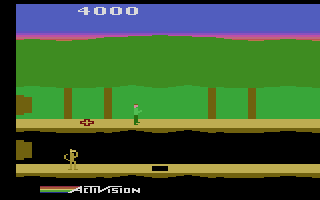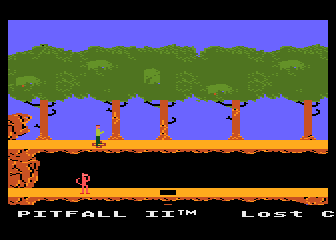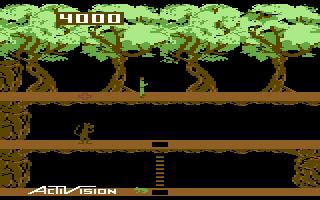Source: Activision Fun Club News – Summer 1984 – – Pitfall II: Lost Caverns
While Super Mario Bros. may be the game that popularized the smooth, continuously scrolling adventure game, it was built upon previous ideas. Before programmers knew how to or had sufficient hardware resources for continuous scrolling, similar games worked by just switching screens when you reached the other side of the screen or wherever the exit was. There were tons of games that worked this way…Impossible Mission, Spelunker, and even the original Donkey Kong could fall into that category among tons of others.

The original Pitfall for the Atari 2600 was one such game. However, it was not only limited to a single screen at a time but also limited to having only a few screens at all. Actually, it’s not so much that there are only a few screens its just that there are only a few variations so that most are very similar. Here’s a map of the original Pitfall that someone made from screenshots on the Atari 2600:
Pitfall II: The Lost Caverns was a much larger and more varied game. However, otherwise the mechanics were very similar. Swing on ropes over obstacles, jump over obstacles and creatures that can kill you, swim, collect treasure, etc. Below is a map for Pitfall II made with screenshots on the Commodore 64. Though other versions might have slightly different graphics and sound, the map is still the same.
Pitfall II was available on a fairly wide variety of systems. It was first released for the Atari 2600 in 1984 (the original Pitfall had been released on the same system in 1982). Afterwards, it was ported to the Atari 5200, ColecoVision, TRS-80 Color Computer, Apple II, Atari 8-bit, MSX, Commodore 64 and the PCjr in cartridge format and several other systems. There was even an arcade remake made the following year in 1985.

Pitfall II was perhaps the closest thing to an open world game at the time it was released. It was given rave reviews by almost every reviewer and more recently was listed as the best Atari 2600 game of all time by Retro Gamer. Certainly, anyone interested in classic video games who has not played this one should give it a try on the platform of their choice.

While I am a big fan of the Commodore 64 and that is almost always my platform of choice when it comes to 8-bit games (at least when the game in question is available on the Commodore 64 which it usually was), there is a reason to play this one on the Atari 5200 or Atari 8-bit computers instead. That version has an entire second level. Apparently the programmers of the Atari 8-bit version, while they reused the original Atari 2600 code, added in a whole new level. However, for marketing reasons, it was decided to include it only as an Easter Egg. This level became available to play once the original game was completed. See the map of this level below:
I think I’ve only played the Commodore 64 version and the Atari 2600 version of Pitfall II. While the Commodore 64 version does have better graphics and sound than the Atari 2600 version, it isn’t by as large a margin as you might think. Pitfall II really was one of the best games done on the 2600 and pushed the graphics and sound capabilities to its limits so it is definitely one to pick of for Atari 2600 collectors. One of the reasons that it is so impressive is that it was programmed by David Crane who was no doubt one of the best programmers of Atari 2600 games. In addition to that, the Pitfall II cartridge contains a custom “Display Processor Chip” (also designed by David Crane). This chip added 2K of RAM, additional graphics capabilities and four channel sound (as opposed to the normal 2). Nintendo would take this approach of adding hardware to cartridges later with the NES. Ebay asking price for the Atari 2600 cartridge of Pitfall II seems to be in the range of $20 to $90 depending on condition and completeness so I’m sure they can be had a bit cheaper than that…or there’s a $4,995.00 prototype if you happened to have recently won the lottery. Pitfall II was one of the last major releases for the Atari 2600.

Screen shots above are all from the Commodore 64 version of the game. The ad at the top is from the Summer 1984 issue of Activision Fun Club News which was a newsletter published by Activision in the U.K.









